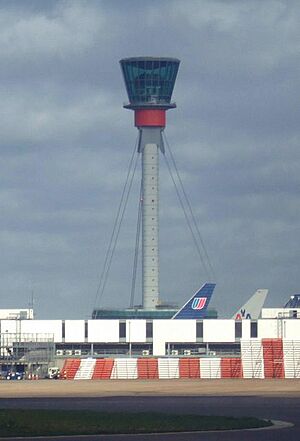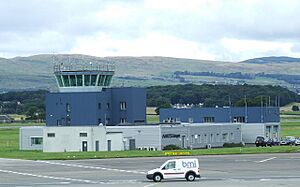NATS Holdings facts for kids
 |
|
| Public-private partnership | |
| Industry | Air travel and airports |
| Genre | Information Services |
| Predecessor | NATCS |
| Founded | 1962 |
| Headquarters | Whiteley, England, United Kingdom |
|
Number of locations
|
London Area Control Centre and London Terminal Control Centre at Swanwick, Area Control at Prestwick, and air traffic control services at UK airports, as well as offices in Dubai and Singapore |
|
Area served
|
UK and Gibraltar airspace |
|
Key people
|
Martin Rolfe (chief executive officer) |
| Services | International air traffic services and consultancy |
|
Number of employees
|
4,227 (2021) |
| Subsidiaries | NATS En-Route PLC NATS Services Ltd |
NATS Holdings, also known as National Air Traffic Services (NATS), helps guide planes safely. It provides air traffic control services for flights in the UK and a large area over the Atlantic Ocean. NATS also manages air traffic at 14 airports across the UK.
The part of NATS that controls planes in the sky (called "en-route" services) is overseen by the Civil Aviation Authority (CAA). The CAA is like a government watchdog that makes sure air travel is safe.
Contents
History of NATS
How NATS Started
NATS began in 1962 as the National Air Traffic Control Services (NATCS). It brought together all the military and civilian air traffic control services in the UK. This made sure that both military and civilian planes could fly safely.
In 1972, the organization changed its name to National Air Traffic Services (NATS). This happened when the new Civil Aviation Authority (CAA) took over the civilian air traffic services. Before this, NATS didn't have its own legal identity.
Becoming a Separate Company
For many years, the leader of NATS would switch between a civilian and a military officer. NATS staff were paid by the CAA and the Ministry of Defence (MoD). The MoD is the government department that manages the UK's armed forces.
In 1996, NATS became its own company. It was still fully owned by the CAA. This change meant that military officers were no longer directly involved in managing NATS.
NATS as a Partnership
In 2001, NATS became a "public-private partnership." This means that part of the company is owned by the government, and part is owned by private companies. The UK government owns 49% of NATS. It also holds a "golden share," which gives it special power to stop certain decisions.
Other owners include a group of airlines (42%), NATS staff (5%), and LHR Airports Ltd (4%). This mix of owners helps NATS get funding and support from different areas.
How NATS is Organized
NATS has about 4,200 employees. These include air traffic controllers, engineers, and support staff. Martin Rolfe has been the CEO of NATS since May 2015.
NATS is divided into two main parts:
- NATS En-Route PLC (NERL): This part is the only provider of civilian air traffic control over the UK. It is regulated by the CAA, which sets the prices NERL can charge. NERL gets its money from fees paid by airlines for using air traffic services.
- NATS Services Ltd (NSL): This part competes to provide air traffic control at airports in the UK and other countries. It also offers related services like engineering, advice, and training.
NATS Operations
In 2019, NATS managed 2.54 million flights. This shows how busy the UK airspace is.
Air Traffic Control Centers
NERL operates two main control centers in the UK:
- Swanwick, Hampshire: This center controls planes flying at higher levels across England and Wales. It also manages lower-level traffic around London and Southeast England. This includes planes approaching major London airports.
- Prestwick Centre, Ayrshire: This center controls traffic over Scotland and Northern Ireland. It also manages planes flying over the northern part of England. The Prestwick Oceanic Area Control Centre guides planes crossing the North Atlantic Ocean.
NATS also uses many radar stations around the UK, like the one on Great Dun Fell in Cumbria. These radars help track planes.
Airport Services
NATS provides air traffic services at 16 UK airports. This includes guiding planes during take-off and landing.
-
 Heathrow Airport ATC tower
Heathrow Airport ATC tower - Heathrow Airport
- Southampton Airport
- Gatwick Airport
- Aberdeen Airport
- Birmingham Airport
- London City Airport
- Luton Airport
- London Stansted Airport
- Cardiff Airport
- Bristol Airport
- Farnborough Airport
- Manchester Airport
- Belfast International Airport
- George Best Belfast City Airport
- Glasgow Airport
 Glasgow Airport ATC Tower
Glasgow Airport ATC Tower
NATS also provides engineering services at some airports. These include:
- London Biggin Hill Airport
- London Oxford Airport
- Highlands and Islands Airports
NATS also works with the Ministry of Defence (MoD). It provides air traffic services at military training areas.
Defence Services
NATS helps military forces around the world share airspace safely with civilian planes. This is important for commercial, political, and environmental reasons. NATS provides services like:
- Aeronautical data (information about air travel)
- Advice for defence
- Air traffic control for military airports
- Surveillance (watching air traffic)
Aquila Partnership
Aquila is a partnership between NATS and Thales. They are working on a program called Marshall for the UK military. This program aims to modernize air traffic management at over 100 military locations. It will make military air traffic services safer and more efficient.
Engineering Services
NATS provides engineering services for:
- Control center systems (the computer systems that help guide planes)
- Airport technology (equipment used at airports)
Consultancy Services
NATS offers advice to other organizations on many topics, including:
- Airspace design (how flight paths are planned)
- Capacity planning (how many planes an airport can handle)
- Safety management
- Technology projects
Information Services
NATS provides important information services, such as:
- Aeronautical charting (creating maps for pilots)
- Procedure design (planning how planes take off and land)
- Wind farms planning and consultancy (helping to make sure wind farms don't interfere with radar)
Former Operations
Past Control Centers
The London Air Traffic Control Centre at RAF West Drayton operated until 2007. Its services then moved to Swanwick. Scottish air traffic control moved to the new Prestwick Centre in 2010. This center also took over functions from the Manchester Area Control Centre, which then closed.
Past Airport Services
NATS had a partnership called FerroNATS with a Spanish company, Ferrovial. FerroNATS provided air traffic control services at nine airports in Spain. In February 2023, FerroNATS was sold and renamed Skyway.
Working with Other Organizations
NATS works with many other organizations around the world.
- SESAR: NATS is a member of SESAR (Single European Sky ATM Research). This group works to modernize air traffic management in Europe.
- A6 Alliance: This is an alliance of major European air navigation service providers (ANSPs). They work together to improve air traffic control in Europe.
- Borealis Alliance: This alliance includes ANSPs from Denmark, Estonia, Finland, Iceland, Ireland, Latvia, Norway, Sweden, and the UK. They are working to create "free route airspace" across Northern Europe. This means planes can fly more directly, saving fuel and time.
- Functional Airspace Block (FAB): In 2008, the UK and Ireland created the first operational FAB. This helps their air traffic control services work together more smoothly.
- CANSO: NATS is a member of CANSO, an international group of companies that provide air traffic control services.
- ESSP: NATS is a shareholder in ESSP, a company that operates a satellite navigation service for Europe.
NATS is known for its work in the UK, but it also provides air traffic and advice services in over 30 countries. This includes places like Singapore, the United States, and Qatar.
Notable Incidents
Volcanic Ash Cloud (2010)
From April 15 to 20, 2010, NATS had to restrict flights in UK airspace. This was due to a volcanic ash cloud from the eruption of the Eyjafjallajökull volcano in Iceland. Volcanic ash can be very dangerous for aircraft engines. NATS worked with weather experts and the government to keep flights safe.
Computer System Failure (2014)
On December 12, 2014, a computer system failure at NATS caused flight delays. The problem lasted about an hour. It was caused by a single faulty line of computer code. Even though it was fixed quickly, some flights were still affected.
Major Technical Incident (2023)
On August 28, 2023, NATS had a major technical problem. This happened on one of the busiest travel days of the year. The incident lasted about three hours, but it caused many delays and cancellations. Around 27% of all flights to and from UK airports were cancelled that day. Many flights were also cancelled the next day.
See also
- History of air traffic control in the United Kingdom
- Linesman/Mediator

